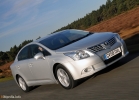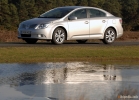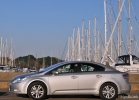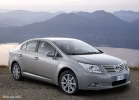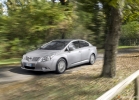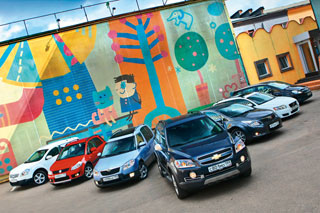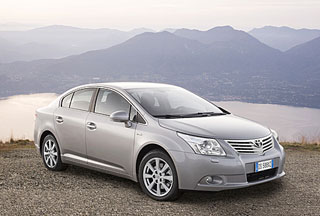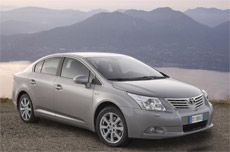Toyota Avensis test drive since 2009 sedan
How much is half a liter of Japanese?
 A new Soviet ambassador arrived in the country of rising sun. On the first working day, the Japanese secretary, who was still at the previous chef, looks with a cup of tea to his office and asks with a polite smile: sir, you are? Or do you have a fig with your COMANs?
A new Soviet ambassador arrived in the country of rising sun. On the first working day, the Japanese secretary, who was still at the previous chef, looks with a cup of tea to his office and asks with a polite smile: sir, you are? Or do you have a fig with your COMANs? We will talk today, of course, not about tea or vodka, and not even about Sake, but about the working volume of the engine. What gives an increase in two hundred cubes? And five hundred? And a liter? How will this affect the dynamics, on the fuel consumption? What will be the equipment and how much will the prices be different between modifications of the same model with different liters?
Naturally, all this can be found out using technical catalogs and price lists of car dealerships. But living sensations are sometimes not just eloquent than dry numbers, but sometimes more precisely data from the avenues.
We decided to focus on four Japanese manufacturers. From each company we skated two cars. (All couples belong to different classes of cars.)
So, two last generation Honda-Civic 1.4 liters and 1.6 l, Toyota-Avensis 1600 cm3 and 2000 cm3, two Nissan-Maxima 2 and 3 liters, respectively, and, finally, a couple of updated Mitsubishi-Pajero 3000 and 3500.
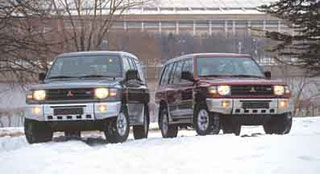 Helled Pajero
Helled Pajero Probably, it makes no sense to describe the very popular Mitsubishi Pajero we have. This is one of the most serious and respected jeeps. Honored Master of Sports, an exemplary worker and a family man. True, since last year, along with the usual option, cars of the GLS versions with changed facial cladding and the shape of the wheel arches began to come on sale. By the way, the modernization is somewhat controversial, and many people still believe that the traditional design looks cooler, although the new outfit is always good because the new one.
We received two long -counter seven -seater jeeps in the GLS luxury design, with mechanical gearboxes and gasoline engines. Gasoline engines intended for Pajero, and only two 3 liters and 3.5 liters. It would seem that the difference is small. But then you remember how the seats pressed us in the back when accelerated on the three -door Pajero 3.5. Yes, in catalogs, the power of this Mitsubishi SUV is 208 hp. Against 181 hp The three -liter version has. Perhaps a more weighty and solid five -door option will not give the same sensations, but it should also break away. Check.
Having been flesh along the Moscow streets and the avenues, we got used to these heavy and slightly clumsy machines and were able to feel all the nuances and differences of their personality: from internal content to character and behavior. So, in the standard of the equipment that we received, a more powerful version included additionally an electric drive of the front seats, the finish for the wood panel, a wood steering wheel, and, in our opinion, the most interesting variable adjustment of shock absorbers. This adjustment has three stiffeners, as evidenced by the lamp on the board of the devices, and the control is displayed on the key to the right of the driver. We try to go through the same podobons on a soft, average (which complies with a three -liter standard) and hard modes. The difference is significant. With low speed and significant irregularities, the most smooth adjustment of the suspension significantly reduces shaking, and on the highway, on the contrary, the most clamped shock absorbers perfectly hold turns and swallow longitudinal waves. The thing is rare and incomparably more useful than the altimeter and the roller installed on these cars.
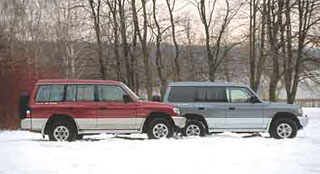 Dynamics. We repeatedly started nearby and the conclusions slightly disappointed us. About 80 km/h, both jeeps walked his nose to the nose, and only then a 3-liter, as it were, rushed into the wall, and the 3.5-liter continued to smoothly gain move. In this case, we did not conduct measurements, but I wanted not only to clarify the acceleration data to 100 km/h, but also to find out how it really happens. Looking into the instructions, we were surprised to find that the power is more than the liths of the engines ... fell compared to the previous series! For as much as fourteen forces, and the weak threw off only four horses. They say that this is justified by saving fuel, but right, this approach is more familiar to small motors, but the most voluminous engine of the family has the right to spend as much gasoline as it is necessary for a powerful start. The numbers say that the acceleration of up to a hundred in a 3.5-liter SUV has changed from 10.5 to 11.3 C, and the maximum speed remained the same. The three -liter version has preserved the indicators at the same level.
Dynamics. We repeatedly started nearby and the conclusions slightly disappointed us. About 80 km/h, both jeeps walked his nose to the nose, and only then a 3-liter, as it were, rushed into the wall, and the 3.5-liter continued to smoothly gain move. In this case, we did not conduct measurements, but I wanted not only to clarify the acceleration data to 100 km/h, but also to find out how it really happens. Looking into the instructions, we were surprised to find that the power is more than the liths of the engines ... fell compared to the previous series! For as much as fourteen forces, and the weak threw off only four horses. They say that this is justified by saving fuel, but right, this approach is more familiar to small motors, but the most voluminous engine of the family has the right to spend as much gasoline as it is necessary for a powerful start. The numbers say that the acceleration of up to a hundred in a 3.5-liter SUV has changed from 10.5 to 11.3 C, and the maximum speed remained the same. The three -liter version has preserved the indicators at the same level. We add that at the stable speeds of the driver, a cruise control in the standard of a more powerful car will please, and the owner’s pride can amuse the number 3500, applied to the rear wing.
Fuel consumption indicators in two versions differ by no more than 5-7%.
Get the conclusions yourself, given the difference of 5 thousand dollars, but do not forget about the above additional amenities that the more expensive modification has.
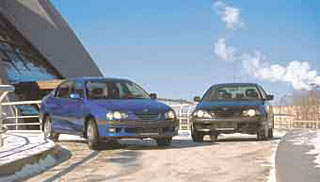 Fly to the sun and go home soon
Fly to the sun and go home soon Toyota-Avensis Typical Class D car on a European scale. And it is intended mainly for Europeans. And therefore, with a certain stretch (given the quality of the roads), and for us. Although in comparison with competitors, Avensis even wins in Russian conditions. This is due to energy -intensive pendants, swallowing both large and small irregularities, and extremely clear and easy control. Our short test only confirmed what was said. Avensis is suitable for both a beginner and an experienced driver.
We compared machines with 1.6 liters in the performance of Linea Terra (Line of the Earth) and 2.0 Linea Sol (Sun Line).
Even in the standard execution of the earth's Avensis, it is equipped very well: the electric drive of the front glasses and mirrors, two airbags, remote opening of the locks from the button on the key, the tachometer and the meter temperature meter on the instrument board. You can’t even talk about the power steering and the central castle, but five (!) Head restraints in the cabin are both concern for passenger security and car class indicator.
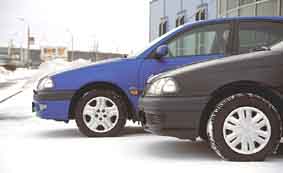 We will now move to a more expensive sunny version. The velor casing of the seats and the trope of the torpedo under the tree are the first to catch the eye. Hearing will please a very, very good -sounding radio. Both a leather bagel and a knob of the gearbox lever are more convenient. Taking a closer look, we also find the air conditioner, the heating buttons of the front seats and the washer washers, as well as the inclusion of the front fogs. And the rear windows are controlled by an electrician.
We will now move to a more expensive sunny version. The velor casing of the seats and the trope of the torpedo under the tree are the first to catch the eye. Hearing will please a very, very good -sounding radio. Both a leather bagel and a knob of the gearbox lever are more convenient. Taking a closer look, we also find the air conditioner, the heating buttons of the front seats and the washer washers, as well as the inclusion of the front fogs. And the rear windows are controlled by an electrician. What didn't you like? Four adjustments of the driver's seat allow you to fit it under any growth, but perhaps either a Japanese or a woman painfully can get to these adjustments. Personally, I had to stop and open the door for this.
In addition, the gas pedal is so clamped between the central tunnel and the brake pedal that, with the reverse course of the foot of the large -size boots, it burns to catch on this very brake pedal.
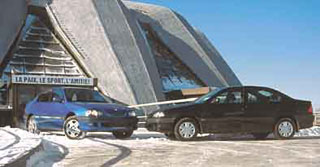 Well, now we go together on the free road and stand on the neighboring stripes. Roof. Start. The two -liter machine, as stung, rushes forward. Nine and three to hundreds are very good for a calm family sedan. And subjective sensations suggest this car will bring you out of many troubles.
Well, now we go together on the free road and stand on the neighboring stripes. Roof. Start. The two -liter machine, as stung, rushes forward. Nine and three to hundreds are very good for a calm family sedan. And subjective sensations suggest this car will bring you out of many troubles. If you do not look at the older sister, then the dynamics of 1.6 will not disappoint. A modern hundredth engine will help to compete with much more impressive cars. Although the craving on the bottoms is noticeably higher than the kopeckoy, throw the clutch and do not touch the gas, at least on the first, at least on the second. He does not stall, crawls slowly. One and six motor should be twisted. Unless, of course, you are lazy and experience allows you.
What can you tell about this sweet couple? Toyota offers Avensis not too cheap, and if you are ready to fork out for the extra two glasses of liters (400 ml) for five more greenery, then go for it, and if not, then you won’t lose, the price for this class will immediately seem acceptable. By the way, do not save on the consumption of gasoline, in both versions Avensis consumes it moderately.
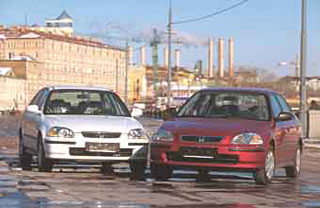 Civilized Civic
Civilized Civic The third in a row, but not in value, a couple of Japanese we chose Honda-Civic. And although the difference between the most modest (1.4 liters) and the most powerful (1.6 l) cars in our terminology in only one glass (so far, because we are driving!), Their power differs 1.8 times. 160 horses from a motor of 1600 cubic meters in a five -seater four -door sedan on this can only Honda. True, you will have to turn the engine up to 7-7.5 thousand revolutions. But with easily and clearly sticking mechanics and powerful clutch, this is only an active driver.
Let's start for comparison with a low -power (90 hp) version. A simple, comfortable car, without bells and ground. A characteristic Honda flat hood and a harsh suspension. Great passage of turns. Good dynamics. Of the options only electric glasses and electric mirrors. No more delights. And gasoline, by the way, is ninety -second savings! The car is ascetic and in some ways self-sufficient.
In reliable hands, a small quartet under the hood will sing high tones harmoniously and harmoniously. It would seem what else is needed?
Now let's try hotter. Let's see what a super -componated bicopian engine is capable of with a change in the phase of gas distribution both at the inlet and on the release. We’ll sink tight and be sure to fasten. We accelerate gradually to stretch pleasure. From the next traffic lights, outlining the snake of the free path between the rows of crawling quietkeys, we boldly drown the gas to the floor. If only to keep the trajectory. The brakes will no longer help us. And the mirrors, by the way, is also unnecessarily, because there was no other Civic with the same engine from behind. Only two pedals, the steering wheel and the gearbox lever are needed. The skin of the steering wheel cools the sweaty palms. The baseball cap with the inscription Honda is pushed on the forehead from the bright sun. I do not hear the sound of the motor. He probably stayed somewhere behind. Although, probably, it only seems so. May the Lord God and the traffic police forgive me. The whole stream remained far beyond
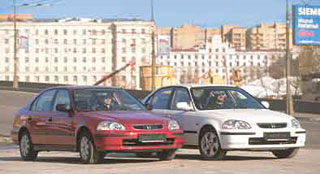 his back and disappeared from sight. One more. Again I quickly seep through it. I stumble upon another. Again I pass easily. At what speed are the cars? Apparently, somewhere about seventy. And I? A quick look, stealthily, on a speedometer. What, already one hundred and eighty?! And the stroke of the accelerator pedal is still large, and you can noticeably add. That's enough, nerves at the limit. One hundred and fifty for me is enough. Just joking, of course. After all, I am not alone on the road. Although sensations are comparable, probably with a flight, when you are focused and peacefully sitting at the helm of an airplane or glider.
his back and disappeared from sight. One more. Again I quickly seep through it. I stumble upon another. Again I pass easily. At what speed are the cars? Apparently, somewhere about seventy. And I? A quick look, stealthily, on a speedometer. What, already one hundred and eighty?! And the stroke of the accelerator pedal is still large, and you can noticeably add. That's enough, nerves at the limit. One hundred and fifty for me is enough. Just joking, of course. After all, I am not alone on the road. Although sensations are comparable, probably with a flight, when you are focused and peacefully sitting at the helm of an airplane or glider. Already calmed down, after the stop, we consider how this modification is rich in. Outside and below ABS, sports suspension, disc brakes from the back, cast discs are 15; In the cabin, sports bucket seats with excellent lateral support, air conditioning, two eirbegs. It is a pity only the radio is very mediocre.
The adjustment of the air temperature inside the cabin in a Japanese archaic lever made us laugh, it is inconvenient to move it left and right.
Well, these are trifles of both advantages and disadvantages. The main power unit is the main thing here. We would not want to offend a Japanese woman with a 1.4 -liter engine at all, the car is also not bad, and the price is generally almost one and a half times less. But Honda-Civic 1.6 l 160 hp Just a rocket! Drivers Car car for a driver. And for this, in our opinion, no money is a pity.
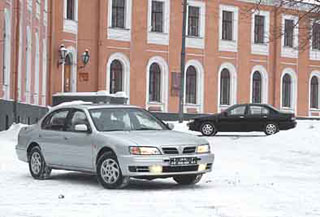 If nissan, then maxima
If nissan, then maxima We finish our test with two representatives of the business class of the Japanese concern Nissan. And the difference in volume of cars should also be a solid 1 liter. Of course, this is Maxima QX. Unlike Mitsubishi, Toyota and Honda, equipped with mechanical checkpoints, we dared to take Nissans with machine guns. Agree that this is more consistent with the image of a large machine. Both two- and three-liter cars in modification SE are not much different in configuration. Thrill is complemented by cruise control and a differential of increased friction on the front drive wheels. Our copy turned out to be equipped with an electric lover. And a high driver, even at the lowest position of the seat of the edge of the hatch, is almost touching the crown. So such buyers will advise the option without a hatch will be higher than three or four centimeters.
Otherwise, both cars have all conceivable and inconceivable options from leather seats with servo drive to Superlock. (A system that blocks the door from the inside, even if the glass is broken, so the attacker will have to make your way through the window opening.) Four pillows (including side), two radio antennas (electric and active), the board and many different differences.
The subject of special pride of the manufacturer engines. The same in design and even in the course of the piston, and different only in volume of 2 or 3 liters. Due to the use of light alloys and a thorough computer study of all elements, the weight of the engines is reduced to the limit. At idle and in the cabin and nearby, on the street, you will not hear the engine turned on. Sometimes you catch yourself thinking that the engine has stalled, but not it works!
Our riding impressions dispersed with data on the acceleration of the manufacturer. It seems that in the life of Maxima is much more dynamic than it should be. The first we got a two -liter version. Let's honestly, if we were not informed about this and all the nameplates seized us, we would confidently summarize: yes, a good threek, great craving. By the way, how much strength is there? One hundred seventy?. But we already knew ahead of time that this car with a two-liter engine has only one hundred and forty horses. Apparently, these are the right horses, and both power and torque are also distributed correctly, at least for a car of this level at average speeds.
How then does a three-liter engine pull at one hundred and ninety-three forces? Of course better! Better, but not for a whole liter of volume. It seems that you compare 2 and 2.5 liters. Or 2.5 and 3. There is a difference, but the advantage, given the price, is still in a two-liter model. And the price for the business class is simply tempting.
Let's summarize. Probably, all our current couples do not need to be compared with each other. If the buyer tuned in to Pajero, he will not buy Avensis. If you want to have a representative car, then Civic is not a competitor to Maxima. Recall that we are talking about whether to pay extra to five to seven thousand dollars for unnecessary convenience and engine power. The author attributes himself to active drivers and easily starts on the road. I like fast, dynamic cars that allow you to behave confidently and make maneuvers at the verge of risk. But, overwhelming the heart, I will say from all the steam running out of all these days, my choice would fall on weaker and cheap versions. Why? Yes, just from healthy economy, in which now, in the last six months, it is not a shame to admit.
Perhaps many will not agree with this conclusion. And, thank God, that people who still believe that if you spend money are on a complete coil have not been transferred. And they will choose, of course, the most charged and steep version. Well, to each his own.
Vladimir Smirnov
A source: Cars
Toyota Avensis test driven video since 2009
Toyota Avensis Crash Video since 2009
Toyota Avensis test drive since 2009
Toyota Avensis Crash Test since 2009
Krassh Test: Detailed Information90%
Driver and passengers
53%
Pedestrians
86%
Children-passengers
86%
Active security system

